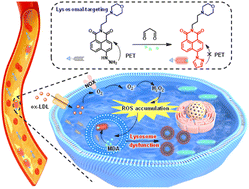Lysosomes, serving as the digestive centers in cells, play a crucial role in lipid metabolism, inflammatory regulation, and cellular homeostasis. The bidirectional vicious cycle between lysosomal dysfunction and oxidative stress synergistically promotes the occurrence, development and instability of atherosclerosis. Therefore, accurate assessment of lysosomal oxidative stress contributes to monitoring atherosclerosis progression and facilitating early diagnosis. Herein, we constructed a malondialdehyde-activated fluorescent probe (Lyso-Np-Hy) by combining naphthalimide dye with a hydrazine group to evaluate lysosomal oxidative stress in atherosclerosis. Lyso-Np-Hy possessed high specificity and sensitivity to malondialdehyde in living cells and showed excellent subcellular localization of lysosomes. Importantly, the probe could monitor the malondialdehyde levels in lysosomes at different stages of atherosclerosis. This study provides a novel chemical tool for evaluating lysosomal dysfunction and tracking the progression of atherosclerosis.


